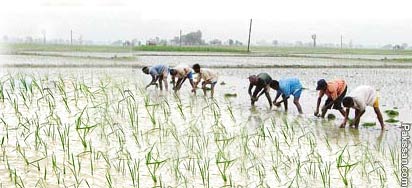Late paddy sowing
 THE
paddy growers are hard-pressed to cultivate rice. Plantation
of the crop is still going on because of delay in
availability of water and even at the risk of lower yield
per acre. This year?s Kharif has been the worst for paddy
growers because of severe water shortage.
THE
paddy growers are hard-pressed to cultivate rice. Plantation
of the crop is still going on because of delay in
availability of water and even at the risk of lower yield
per acre. This year?s Kharif has been the worst for paddy
growers because of severe water shortage.
Agriculture experts believe paddy yield would be 20-30 per
cent less even if the sowing target is met. An assessment by
the Crop Reporting Service of Sindh Agriculture Department
shows that paddy sowing was reported at 46 per cent of the
target by July 23 against 82 per cent in the corresponding
month last year. About 22 per cent water shortage was
recorded in April, 21 in May and 28 per cent in June.
Last year, rice was planted on 708,000 hectares and the
production was 2.4 million tons. The sowing target this
season is the same as that of last year- 642,000 hectares.
Area under rice cultivation in Sindh is around 1.6-1.8
million acres and would have been bigger had the Kotri
barrage?s command area not been intruded by sea. The Sindh
Abadgar Board (SAB) claims that out of 2.8 million acres of
Kotri?s command area, paddy used to be grown on 1.5-1.8
million acres, but around 600,000 acres have been devoured
by the sea.
As a result of the late availability of water, plantation of
paddy would continue till August end in lower and upper
Sindh regions. Non-perennial canals of Sukkur barrage are
operated on May 5. In lower Sindh, Kharif begins in early
April subject to availability of water which places farmers
in somewhat comfortable position to prepare the nursery on
time.
The maturity period of nurseries varies between 20 to 25 and
30 to 40 days depending on the varieties. If this period
gets prolonged, the yield is bound to be affected. Safe
estimates show that in 25 per cent cases growers are having
belated nurseries.
?Prudent growers will forego their crop and wait for Rabi,?
said SAB?s Abdul Majeed Nizamani. He differs that 46 per
cent sowing had taken place by July this year and says that
it is somewhere between 35 and 40 per cent. He observes that
salinity and water-logging caused by paddy cultivation in
upper Sindh is a big issue which needs to be tackled
effectively.
Paddy cultivation is banned in the Guddu and Sukkur
barrages? command area which is otherwise meant for growing
cotton. The upper Sindh region does not have proper drainage
system and the rising water table is destroying land, civic
infrastructure, trees and orchards.
Sindh contributes 35 to 40 per cent to country?s rice
production. Yet it is always on the receiving end due to
water dispute and faulty implementation of the Water Accord
1991 or unilateral decisions taken in Irsa. Sindh?s internal
mismanagement of water distribution aggravates the situation
further.
Generally coarse variety is grown in Sindh including Irri-6,
DR83, DR92, KS282, Shahkar, KS82, and KS133. Nursery for
Irri-6 is prepared by May 15 to June 16 for transplantation
by July 17. For late varieties like DR92, KS-82, DR82 and
Shahkar transplantation takes place in June and July. Irri-6
is popular in Sindh, followed by DR92 and DR83, Shahkar,
KS82 and KSS133. Growers would sow DR92 and DR83 as late
varieties though with less yield as compared to Irri-6 with
60 maunds per acre yield on an average against potential of
80 maunds.
Hybrid seed is another choice of growers of lower Sindh
where climatic conditions suit it. But due to higher
moisture level, millers offer rates to growers that are less
than those offered for other varieties. Growers still find
it affordable in view of high per acre yield of hybrid seed.
Agronomist of Rice Research Institute, Dokri, Nehal Marri,
says growers opt for hybrid seed that produces 80-85 maunds
per acre. Even its late transplantation is affordable for
growers. Last year it was grown on 15-16 per cent land. He
supports the view that late transplantation will lead to 30
per cent drop in paddy production.
Not only poor inflows in the Indus upstream, injudicious
water distribution is another reason that leads to low
yields. Here the tail-end growers, particularly small
farmers, suffer the most.
Courtesy: The DAWN